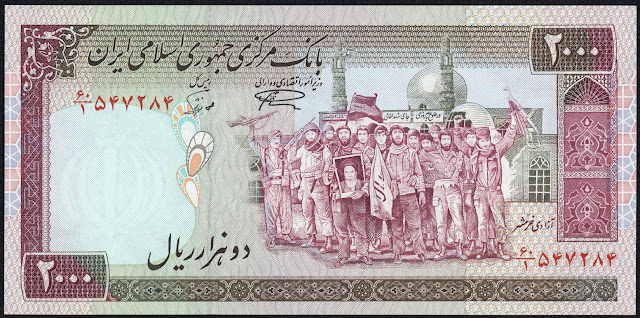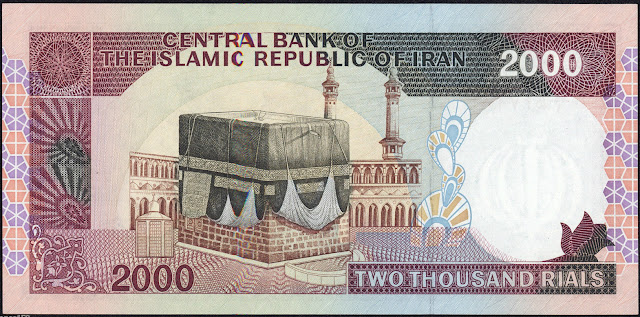Currency of Iran 2000 Rials banknote 1986 Liberation of Khorramshahr
Banknotes of the Islamic Republic of Iran
Revolutionary Series 1981 - 2005
Revolutionary Series 1981 - 2005
Bank Markazi Iran - Central Bank of the Islamic Republic of Iran
Iranian banknotes, Iranian paper money, Iranian bank notes, Iran banknotes, Iran paper money, Iran bank notes.
Obverse: Iranian forces celebrate the liberation of Khorramshahr at the city’s Grand Mosque, May 24, 1982. Purple, olive-green, and dark brown on multicolored underprint.
Signatures: Dr. Mohsen Noorbakhsh & Dr. Hossein Namazi.
Reverse: The Black Stone, or al-Ḥajar al-Aswad, is the eastern cornerstone of the Kaaba, the ancient stone building, located in the center of the Grand Mosque in Mecca.
Watermark: Allah emblem on first issues & profile of Mohammad Fahmideh.
Printer: Thomas De La Rue & Company, Limited (without an imprint).Signatures: Dr. Mohsen Noorbakhsh & Dr. Hossein Namazi.
Reverse: The Black Stone, or al-Ḥajar al-Aswad, is the eastern cornerstone of the Kaaba, the ancient stone building, located in the center of the Grand Mosque in Mecca.
Watermark: Allah emblem on first issues & profile of Mohammad Fahmideh.
Banknotes of the Islamic Republic of Iran
Revolutionary Series 1981 - 2005
The Liberation of Khorramshahr was the Iranian recapture of the port city of Khorramshahr from the Iraqis after 575 days on 24 May 1982 during the Iran–Iraq War. The Iraqis had captured the city early in the war on 26 October 1980. The successful retaking of the city was part of Operation Beit ol-Moqaddas (Jerusalem). It is perceived as a turning point in the war and the liberation is celebrated in Iran on its anniversary, 24 May.
The battle
The city remained in Iraqi hands until April 1982, when the Iranians launched Operation Beit ol-Moqaddas to recapture the Khuzestan province. The first attack (from 24 April to 12 May 1982) utilized approximately 70,000 Iranian army troops and Revolutionary Guards that succeeded in pushing the Iraqi forces out of the Ahvaz-Susangerd area while sustaining heavy casualties. The Iraqis withdrew back to Khorramshahr and, on 20 May, launched a heavy but unsuccessful counterattack against the Iranians who stood their ground no matter the cost. An all-out assault on Khorramshahr was then launched by Iran, which captured two Iraqi defense lines in the Pol-e No and Shalamcheh region. The Iranians gathered around the Shatt al-Arab (known as Arvand Rud in Iran) waterway, surrounded the city and began a second siege. The Iranians finally recaptured the city on 24 May 1982 after two days of bitter fighting and heavy losses.
Aftermath
In re-taking the city, the Iranians captured approximately 19,000 soldiers from a demoralized Iraqi Army. On the other hand, Saddam Hussein was shocked and furious by the defeat in Khorramshahr and at the fact that the Iranians had pushed on despite sustaining heavy casualties. The Iranians had even been forced to commit their reserves in order to keep on driving back the Iraqis. Iranians had shown incredible determination and an iron will. Saddam ordered the execution of a number of top Iraqi officers responsible for the defense of the city. After the defeat at Khorramshahr, Saddam Hussein executed several of his top generals, such as the commander of the 9th Division.
Three days after the liberation of Khorramshahr the calls for ceasefire in the Iran-Iraq war was raised and leaders started to discuss about it.
Iranians celebrate the anniversary of Liberation of Khorramshahr every year.
In popular media
The Liberation of Khorramshahr had been the subject that get the attention of some war time city films such as the pasdaran Army Television Unit’s recatureing Khorramshahr in 1983, Another Growth by Homayun Purmand in 1982, Forty witnesses and the second narrative: liberation of Khorramshahr by Kiumarth Monazzah.
There's a popular sad Persian song, "Mammad Naboodi" (ممد نبودی, meaning "Mammad [colloquial variant of Mohammad], you were not there [to see the city has been liberated]") by Gholam Koveitipoor, which is about Mohammad Jahanara, the Pasdaran commander who was one of the last few Iranians to leave Khorramshahr when it fell to the Iraqis. He would go on to fight in the Siege of Abadan and lead Iranian forces to recapture Khorramshahr, but he died on May 24, 1981 in a plane crash incident, before observing the eventual liberation of the city.
The Kaaba ("The Cube"), also referred as Al Kaaba Al Musharrafah (The Holy Kaaba), is a building at the center of Islam's most sacred mosque, Al-Masjid al-Haram, in Mecca, al-Hejaz, Saudi Arabia. It is the most sacred site in Islam. It is considered the "House of Allah (God)" and has a similar role to the Tabernacle and Holy of Holies in Judaism. Wherever they are in the world, Muslims are expected to face the Kaaba when performing salat (prayer). From any point in the world, the direction facing the Kaaba is called the qibla.
The sanctuary around the Kaaba is called Al-Masjid al-Haram (Sacred Mosque).
One of the Five Pillars of Islam requires every Muslim who is able to do so to perform the hajj pilgrimage at least once in their lifetime. Multiple parts of the hajj require pilgrims to make tawaf, the circumambulation seven times around the Kaaba in a counter-clockwise direction. Tawaf is also performed by pilgrims during the umrah (lesser pilgrimage). However, the most significant times are during the hajj, when millions of pilgrims gather to circle the building within a 5-day period. In 2013, the number of pilgrims coming from outside the Kingdom of Saudi Arabia to perform hajj was officially reported as 1,379,531. In 2014, Saudi Arabia reported having completed Hajj permits for 1,389,053 international pilgrims and 63,375 for residents.

